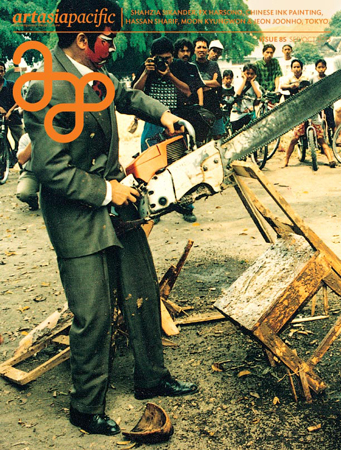Out now
For the September/October issue of ArtAsiaPacific, we consider artists and genres that push forward important conversations of identity politics. Throughout the 1990s, Asia-Pacific artists in the United States and many postcolonial Asian countries made the choice to create art in a vernacular language that wasn’t distinctly “Western.” After 20 years, many of these artists have gained significant recognition, while others have experienced a regressive backlash against their contributions.
Our cover feature delves into the work of FX Harsono, who has played a seminal role in the history of contemporary art in Indonesia. AAP editor at large HG Masters talked to Harsono about his 40-year career addressing the tribulations of Indonesia’s transition from a Dutch colony to an independent yet brutal state after World War II. A pioneering postmodern artist in 1970s and ’80s Indonesia, Harsono has recently explored the violent and largely omitted history of his home country’s genocidal treatment of its Indonesian-Chinese community.
From New York, president emerita of Asia Society Vishakha N. Desai sits down with Shahzia Sikander to discuss the transnational nature of the multimedia artist’s work. In the early 1990s, Sikander helped revitalize Indo-Persian miniature painting, which had flourished in the 16th and 17th centuries on the Subcontinent. Today, contemporary miniature painting thrives as an artistic genre and as a commercially driven practice, fueled by the art market’s thirst for the next “discovery.” Desai and Sikander thrash out this thorny issue in relation to the latter’s international career and the unsettling attempt by some domestic critics to rewrite the history of Pakistani contemporary art.
Chinese ink painting is another traditional genre that is experiencing a cultural renaissance. Beijing-based curator and ink practitioner Tiffany Wai-Ying Beres introduces readers to emerging artists who have embraced the medium. In Seoul, AAP desk editor Jayoon Choi interviews artist duo Moon Kyungwon and Jeon Joonho, known for their interdisciplinary and multimedia works. Having recently received a number of prestigious international exhibition invitations and awards, they explain their fascination with beauty, utopia and the Bauhaus.
Our yearlong project to mark AAP‘s 20th anniversary, 20/20 attempts to pinpoint unconventional works and concepts from 1993 to the present. In this issue, Salima Hashmi, dean at the School of Visual Arts and Design at Beaconhouse National University in Lahore, introduces Durriya Kazi’s mobile art project Art Caravan (1994), while Ranjit Hoskote meditates on a 1993 exhibition by the late Indian painter Bhupen Khakhar. Hisako Hara recalls the first time she saw Japanese Kitchen (1999) by Japanese video installation artist Tabaimo; and Kevin Jones explains the significance of Hassan Sharif‘s long-overdue retrospective, Experiments and Objects 1979–2011, in Abu Dhabi.
In Essays, Uli Sigg, a prominent collector of contemporary Chinese art, draws up a typology of various styles of art collecting. Independent curator Nat Muller compares the past two Home Works cultural forums in Beirut, reflecting on the dramatic changes in the political landscape of the Middle East over the past three years.
In Profiles, Sylvia Tsai sits down with Indonesia’s Melati Suryodarmo, one of the few active performance artists in Southeast Asia. Noelle Bodick whizzes through Hong Kong’s streets with Adrian Wong, who recently created a pop-up bar during Art Basel’s inaugural edition in the Asian metropolis. HG Masters meets Fulya Erdemci, the curator of the 13th Istanbul Biennial, to discuss her conceptual exhibition framework—the public domain as political forum—and its significance after the Gezi Park protests this past summer.
For this issue’s Dispatch we look at the art community in Tokyo, while in One on One, artist Ming Wong draws inspiration from Vladimir Tretchikoff’s Chinese Girl. For The Point, Christie’s senior specialist Ingrid Dudek argues that auction houses can stimulate critical discourse about art. Finally, in Where I Work, we visit Dinh Q. Lê’s Ho Chi Minh City studio as he prepares for his upcoming US gallery exhibition of historic photographs from the American-Vietnam War.
Select articles now online in Arabic and Chinese: artasiapacific.com
Subscribe to the print edition, buy digital copies on Zinio, become a Facebook fan and follow us on Twitter.
